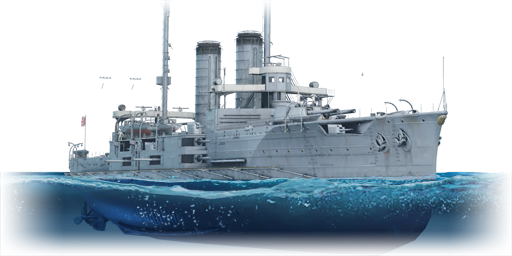



The IJN Ikoma (生駒, namesake: Mount Ikoma) was the second ship of the Tsukuba-class armoured cruisers. Laid down in 1905 and commissioned in 1908 to replace the loss of battleships Yashima and Hatsuse during the Russo-Japanese war, Ikoma and her sister ship Tsukuba were the first capital ships to be designed and built entirely in Japan, albeit with the use of some imported weaponry and components. Due to the urgency of her construction, the Tsukuba-class were plagued with hull strength and stability problems, as well as numerous mechanical difficulties throughout their careers.
Shortly after her commissioning, Ikoma was sent to escort the American "Great White Fleet" on its round-the-world voyage. Ikoma herself would later complete circumnavigation around the world on her own in 1910. After being redesignated as a "battlecruiser" in 1912, Ikoma would go on to serve in World War I, being assigned to protect Allied shipping from German commerce raiders. Ikoma's wartime career was rather uneventful, however, and she would later be scrapped in 1923 in accordance with the Washington Naval Treaty.
Introduced in Update "New Power", the Ikoma is a peculiar ship, being a representative of an "armoured cruiser" design: a heavily-armed ship with guns of numerous calibres and a speed just fast enough to outrun most battleships of its era. Although the Japanese categorized the ship as a battlecruiser, it is anything but. The ship is slow and lacks any firepower compared to true battlecruisers of her era (such as the HMS Invincible or the SMS Von der Tann). However, being an armoured cruiser isn't entirely bad for the Ikoma, as the ship is smaller yet much more armoured than most WW2 cruisers, as well as packing heavy firepower capable of destroying those who underestimate her.
| Ammunition | Type | Armor penetration (mm) at a distance: | |||||
|---|---|---|---|---|---|---|---|
| 1000 m | 2500 m | 5000 m | 7500 m | 10000 m | 15000 m | ||
| HE | 77 | 70 | 69 | 69 | 69 | 69 | |
| APC | 510 | 462 | 390 | 327 | 272 | 189 | |
| Ammunition | Type | Armor penetration (mm) at a distance: | |||||
|---|---|---|---|---|---|---|---|
| 1000 m | 2500 m | 5000 m | 7500 m | 10000 m | 15000 m | ||
| HE | 43 | 43 | 43 | 43 | 43 | 43 | |
| APC | 194 | 162 | 117 | 83 | 61 | 55 | |
| Ammunition | Type | Armor penetration (mm) at a distance: | |||||
|---|---|---|---|---|---|---|---|
| 1000 m | 2500 m | 5000 m | 7500 m | 10000 m | 15000 m | ||
| HE | 34 | 26 | 26 | 26 | 26 | 26 | |
| Ammunition | Type | Armor penetration (mm) at a distance: | |||||
|---|---|---|---|---|---|---|---|
| 100 m | 1000 m | 2000 m | 3000 m | 4000 m | 5000 m | ||
| HE-TF | 12 | 10 | 8 | 8 | 8 | 8 | |
6 × 18 inch Type 38 No.2 B torpedo











Seakeeping |
|---|
Unsinkability | |
|---|---|
Firepower | ||
|---|---|---|